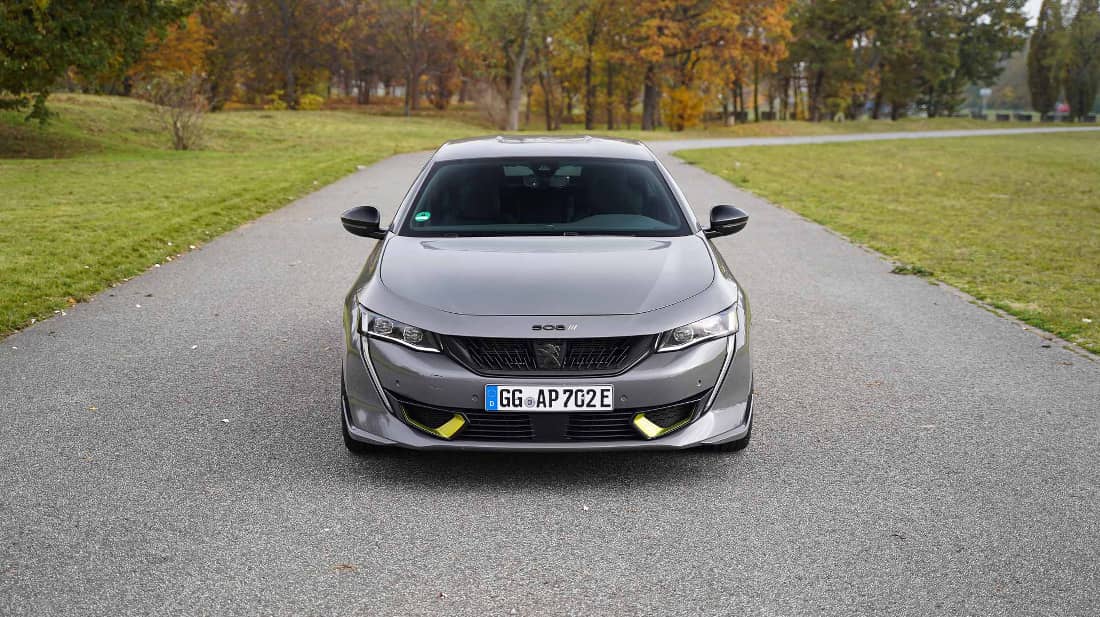
The Peugeot 508 PSE at a glance
With the power of three engines
The air for performance-hungry fathers is getting thin. Where there was once even a selection of V8 engines in the upper middle class – and not only from the German premium manufacturers – one looks for even six-cylinder engines in vain today. The Peugeot 508 PSE (combined fuel consumption: 1.8 l / 100km; combined power consumption: 15.9 kWh / 100km; combined CO2 emissions: 42 g / km) ² also measures a large-volume drive train under the mighty bonnet. A 1.6-liter four-cylinder with turbocharging should fix it. But he gets support from two electric motors that are supposed to arouse the sporting spirit.
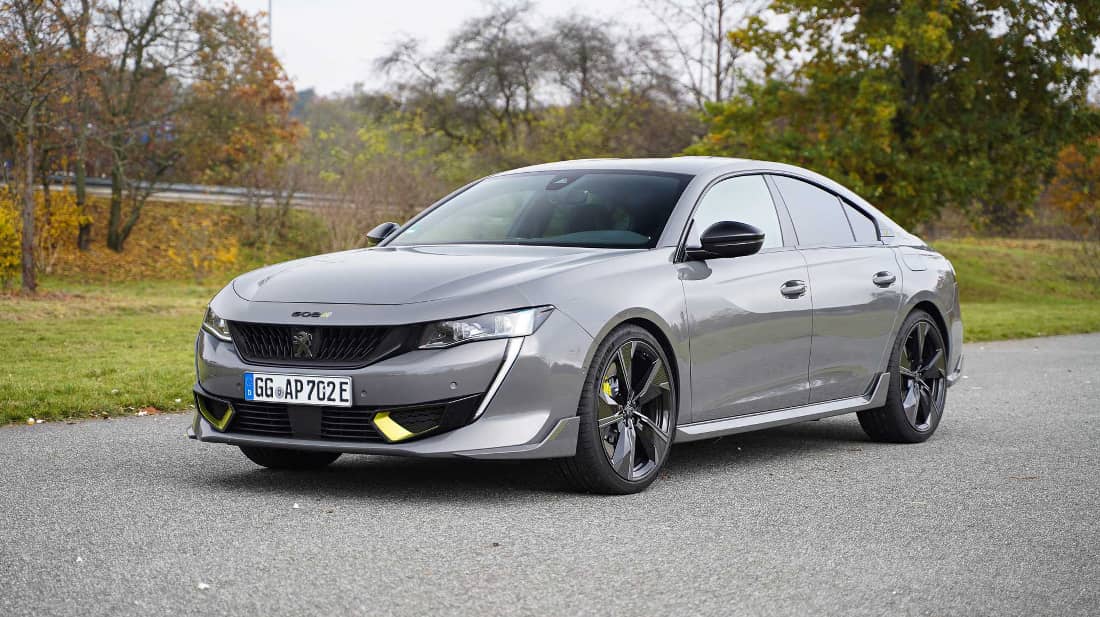
Visually, the Peugeot 508 PSE delivers a convincing performance
The fastest 508 version is also optically dynamic. The noble Selenium gray of the test car forms a wonderful contrast to the neon yellow PSE elements, which are not only to be found in the front of the bumper, but also on the diffuser and the small aero flaps next to the exhaust pipes. The highlight of the Sport Engineered ingredients, however, is the brake system, gigantic 380 mm lightweight brake discs that almost look like chariot wheels, are gripped by bright yellow four-piston fixed calipers and promise great looks. The 20-inch light alloy wheels in paddle wheel design with their Michelin Pilot Sport 4S tires also clearly signal that someone is serious here.
In the interior, however, the styling was a bit more cautious. A few logos on the steering wheel and add-on parts, in addition to an Alcantara / synthetic leather upholstery combination with neon yellow contrasting stitching, must be sufficient for sporty flair. What has remained is the arrangement of the i-cockpit, which takes getting used to, with a low-lying and almost square steering wheel that tries to force the view of the instruments via the valance. However, due to the flat roofline in particular, finding a comfortable seating position will not be easy for everyone. However, if you are within the size range of the French developers, you can make friends with the fresh layout and enjoy the benefits. Because ergonomically it fits – if it fits – surprisingly well.
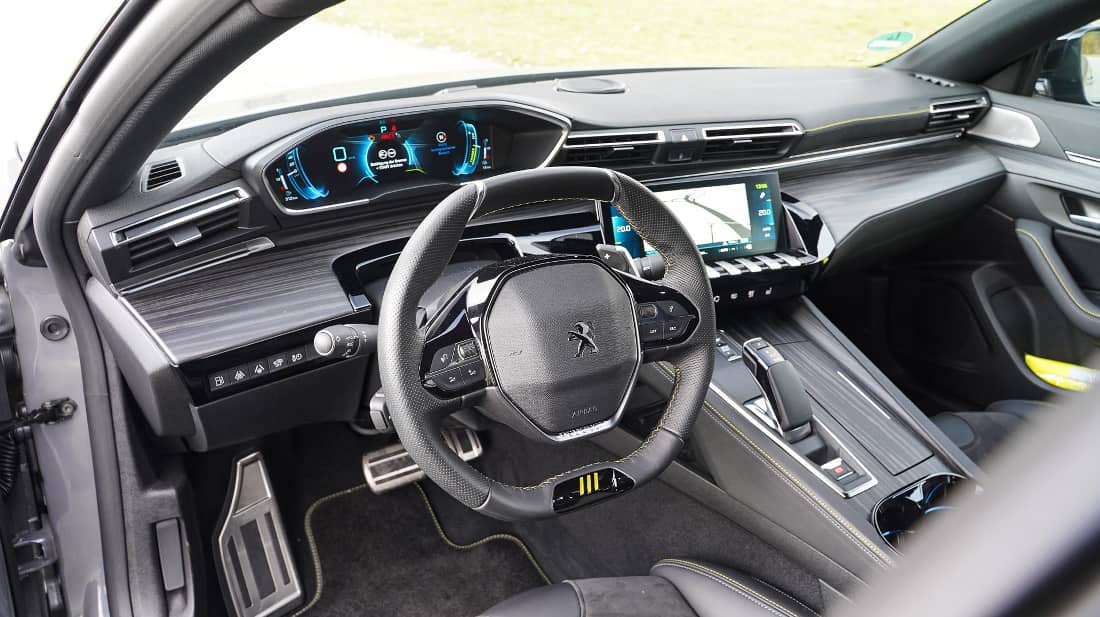
Decent Stellantis equipment level in all areas
In general, “fit” is a good word for many areas of the Peugeot 508 PSE. It shows the advantages of the large Stellantis modular system at least as well as the VW products in their MQB portfolio. From the infotainment offer to the usability to the choice of materials, everything is on a very decent level. There is little room for criticism, although the 508 does not tear up in any area – but not down either. Instead, it is a good average, which is to be understood as praise at this point.
Incidentally, the trunk is not restricted by the hybrid drive. The electrochemical energy store for the two electric motors is hidden under the rear seat bench and in the former transmission tunnel. Like its siblings, the Peugeot 508 PSE has the full 487 liters of cargo volume ready. With the rear seat that can be folded down in parts and the tailgate that swings open, nothing stands in the way of even larger transport tasks.
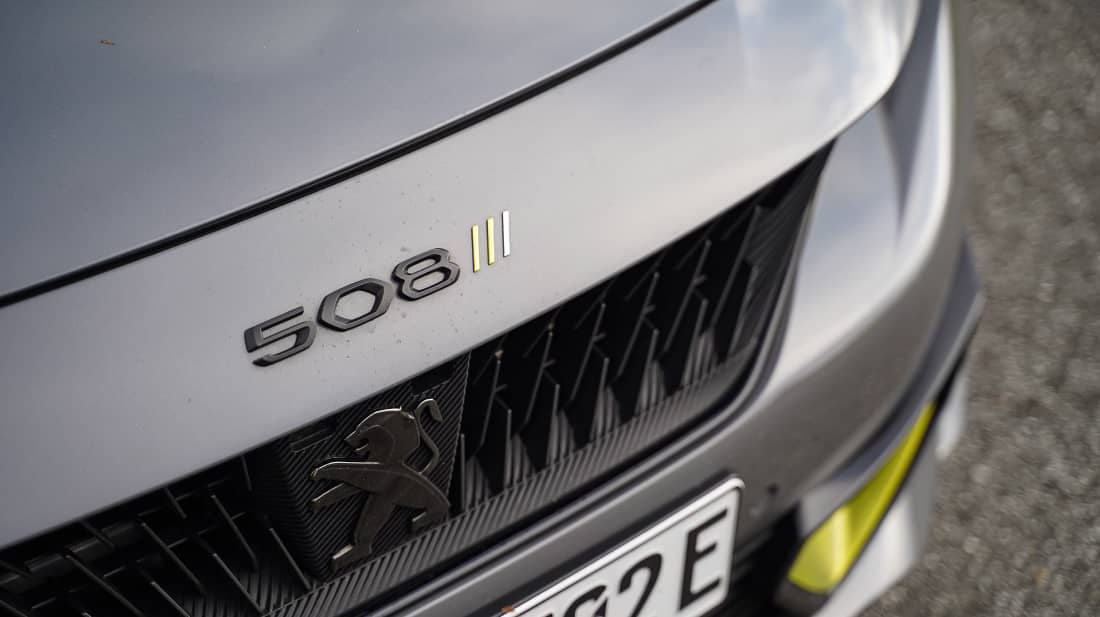
A rich list of ingredients should ensure more driving dynamics
In order to be equipped for sporting tasks in addition to the revised optics and the promising wheel-tire combination, the PSE engineers extensively redesigned the flagship. A track widened by 24 millimeters on the front axle and the widening measuring 12 millimeters on the rear end provide better support for the body in sharp corners and lay the foundation for more rigid chassis kinematics. There are also changes to the stabilizers, the steering set-up and of course the shock absorbers.
Depending on the driving mode – Electric, Comfort, Hybrid, Sport and 4WD are available – the characteristics of all systems are adapted and the performance of the engines available is varied. For the Peugeot 508 PSE it must have been a high development effort, because with several adaptive chassis systems and three motors to be controlled, there are a large number of parameters to be applied.
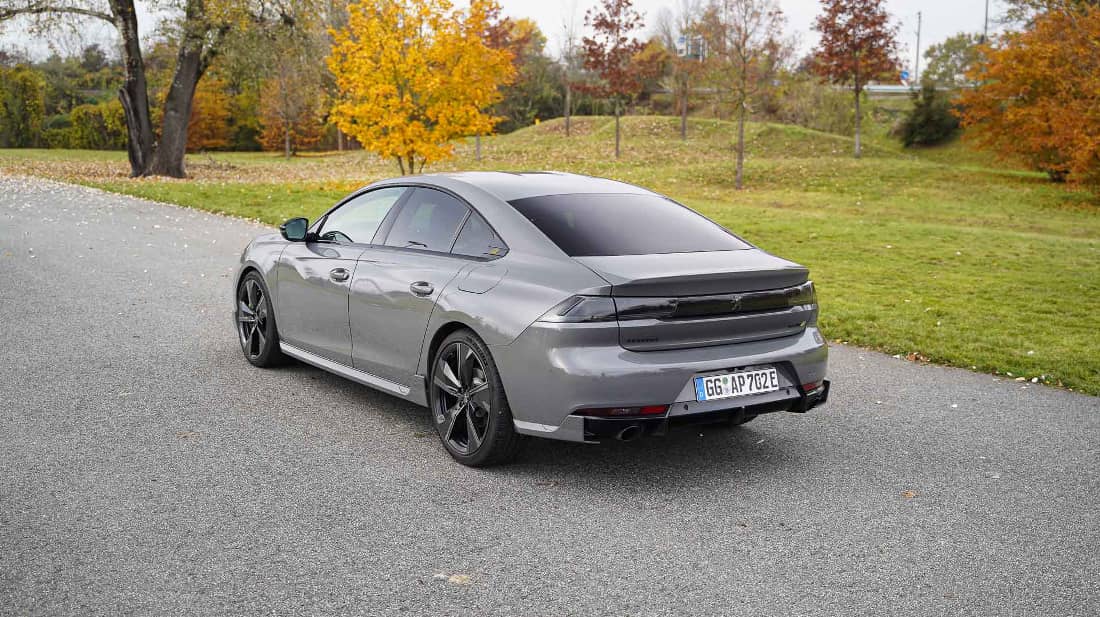
The interaction does not always work perfectly
Normally the Peugeot 508 PSE starts moving electrically. This is ensured by the first electric motor with 110 hp, located between the engine and the gearbox. The 1.6-liter four-cylinder with 200 hp and 300 Nm jumps to the side when the demand is higher. Only when there is a risk of loss of traction or maximum acceleration does the rear-axle motor with 112 hp begin its work. The arithmetic game alone shows that the performance hybrid is a complex matter, because: It is not 422 hp that pulls forward, but according to the manufacturer a maximum of 360 hp and 520 Nm.
In bare numbers, however, the PSE is impressively sporty. Only 5.6 seconds pass for the country road sprint, and the 200 mark is mastered with a good 20.7 seconds. Even the top speed of 250 km / h can be achieved with ease thanks to its design. Because the chassis lies very well on the road even at these extreme speeds.
A big but shows for the first time over 190 km / h. Here the rear axle drive is disengaged and the propulsion slows down noticeably. In general, the Peugeot 508 PSE only brings the potent performance values to the floor if its 11.5 kWh battery (electric range according to WLTP: 42 kilometers; test range: approx. 25-30 kilometers) has sufficient charge in stock. If the energy store is exhausted, things quickly become tough. Because the once so powerful and powerful acceleration gives way to only a very gentle forward thrust – accentuated by the strained tone of the 1,600 engine. In terms of charging speed, the French spend a rather meager 3.7 kW ex works, but an on-board charger with 7.4 kW is offered for an extra charge.
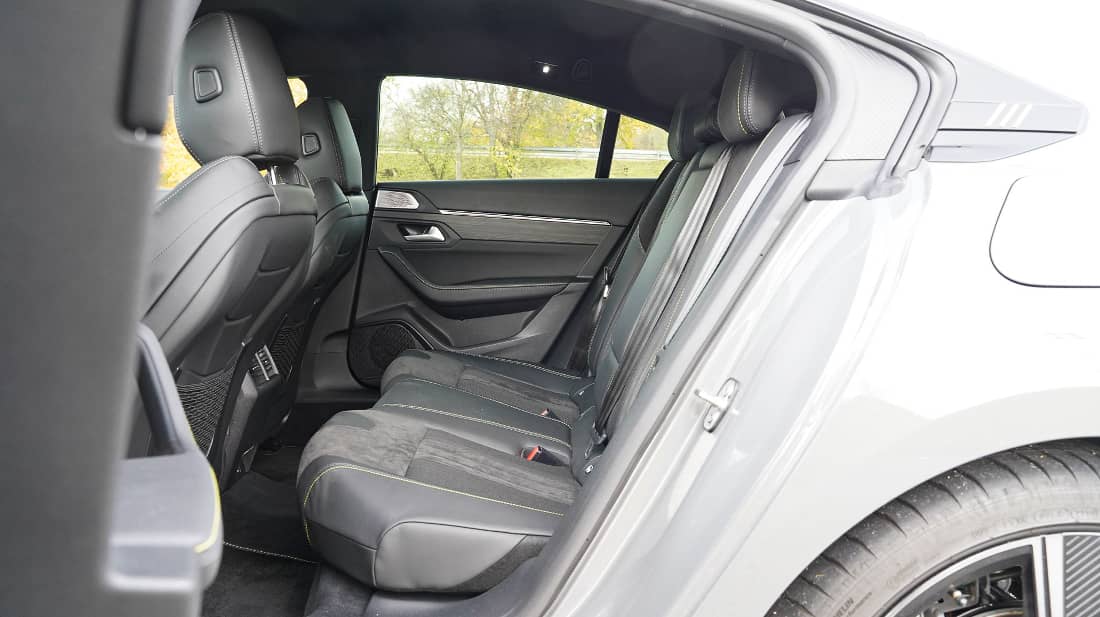
An athlete for special occasions
Driving the Peugeot 508 PSE is a tightrope walk. What fits very well at one moment when the chassis set-up and the power of the three motors are fully deployed, can turn into the opposite in the next. The Frenchman is also a heavy fellow with an unladen weight of almost 1.9 tons, which can no longer be hidden, especially on winding country roads. A more rear-oriented drive strategy design could certainly have helped, but the decision was made for the more cautious, understeering variant.
And so the PSE leaves a mixed impression in terms of its driving dynamics. Objectively, you can’t blame him, but subjectively he’s not nearly as lively as his ancestors or little brothers who still heard the name GTi.
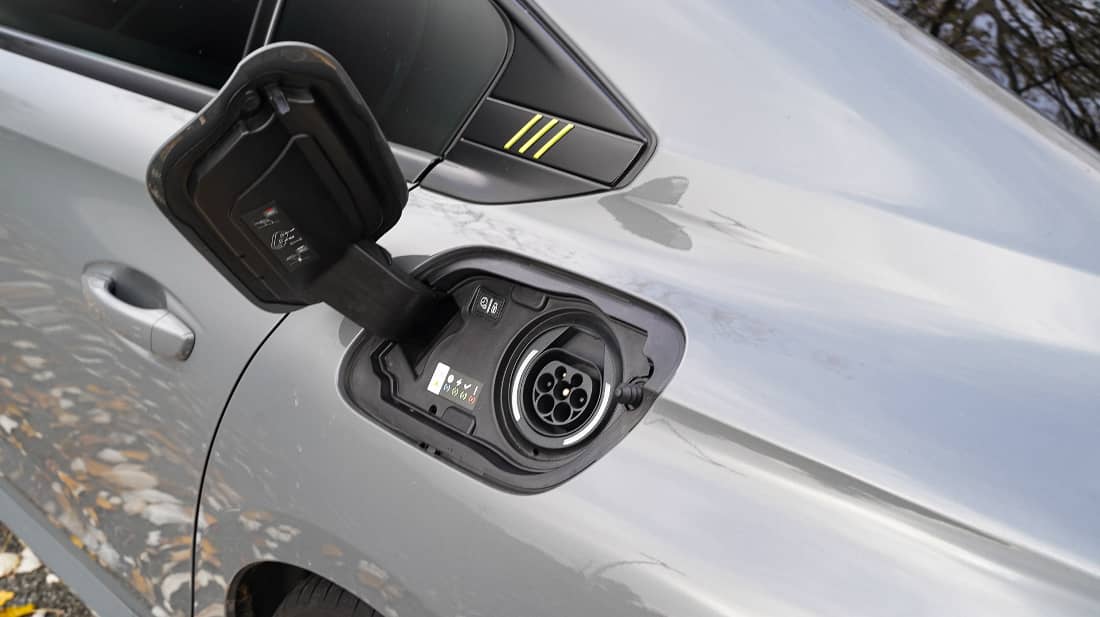
Conclusion
Whose everyday life takes place in short-distance commuting followed by childcare and shopping, will find a very good partner in the comfortable and practical Peugeot 508 PSE, which also looks great. At the right moment, it can also provide great joy on the highway or overland. However, if the idea of driving dynamics is important to you on every kilometer, you should reconsider your decision. But this does not only apply to the Peugeot 508 PSE, this problem is shared by all power hybrids. Because the fun is only great as long as the battery has enough juice for the boosting additional power. (Text and image: Fabian Mechtel)








